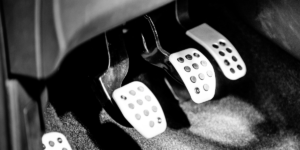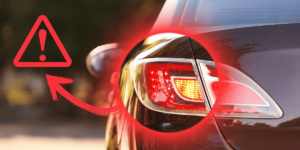Brake rotors are a critical component of your vehicle’s braking system. They are the discs that the brake pads clamp down on to slow down and stop your car. Over time, brake rotors can develop grooves, which can reduce braking performance and make your brakes less safe. This blog post will discuss what causes grooves in brake rotors, the signs and symptoms of grooved brake rotors, how to fix and prevent grooved brake rotors, and answer some frequently asked questions.
What Are Brake Rotors and What Do They Do?
Brake rotors are metal discs that are attached to the axles of your vehicle. When you press the brake pedal, the brake pads clamp down on the rotors, which creates friction that slows down and stops your car. Brake rotors are made of a durable material that can withstand the high temperatures and pressures generated during braking. However, over time, brake rotors can wear down and develop grooves. Brake rotors, also known as brake discs, are a critical component of a vehicle’s braking system. They play a fundamental role in the process of slowing down or stopping a vehicle when the brakes are applied. Here’s a detailed explanation of what brake rotors are and what they do:
1. Functions
The primary function of brake rotors is to work in conjunction with the brake pads to facilitate the process of slowing down or stopping a moving vehicle. When you press the brake pedal, hydraulic pressure is applied to the brake calipers, which in turn clamp the brake pads onto the brake rotors. This action creates friction between the brake pads and the rotors, resulting in the conversion of kinetic energy (the energy of motion) into heat energy. It is this heat energy dissipation that ultimately causes the vehicle to slow down and stop.
2. Physical Characteristics
Brake rotors are typically flat, circular discs that are mounted directly onto the wheel hubs of the vehicle. They come in various sizes and designs, depending on the make and model of the vehicle. Common materials used for brake rotors include cast iron and composite materials, each with its own set of advantages and disadvantages.
3. Heat Dissipation
One of the critical roles of brake rotors is to effectively dissipate the heat generated during the braking process. When the brake pads press against the rotor’s surface, the resulting friction generates a substantial amount of heat. If this heat is not dissipated efficiently, it can lead to a condition known as “brake fade,” where the braking efficiency decreases, potentially compromising safety. Brake rotors are designed with features to aid in heat dissipation, such as cooling vanes and grooves.
4. Smooth Surface for Brake Pads
Another essential function of brake rotors is to provide a stable and smooth surface for the brake pads to make contact with. This ensures consistent and even friction between the brake pads and rotors, resulting in reliable braking performance. Any irregularities or imperfections on the rotor’s surface can lead to uneven wear of the brake pads and reduced braking effectiveness.
Types of Brake Rotors
Here are the most common types:
-
Solid Rotors:
- Solid rotors are the most basic and common type of brake rotor. They have a smooth, solid, and unvented surface without any visible grooves, holes, or slots.
- They are typically used in everyday commuter vehicles and vehicles with standard braking needs. They provide adequate braking performance for regular driving conditions and are cost-effective to manufacture and replace.
-
Slotted Rotors:
- Slotted rotors have narrow channels or slots cut into their surface. These slots are typically machined or milled into the rotor’s face, creating small grooves running parallel to the rotation of the rotor.
- Slotted rotors are versatile and offer improved heat dissipation, water dispersion, and debris removal compared to solid rotors. They are commonly used in both everyday vehicles and performance applications. Slotted rotors are ideal for drivers seeking better braking performance without the high cost of other rotor types.
-
Cross-Drilled Rotors:
- Cross-drilled rotors feature holes drilled into their surface. These holes are evenly spaced and extend from one side of the rotor to the other. The holes can be drilled in various patterns, such as straight, slanted, or curved.
- This type of rotors are often found on high-performance and sports vehicles. They excel in aggressive driving and provide superior heat dissipation, reduced brake fade, and improved wet-weather performance. However, they may be more prone to cracking under extreme stress, making them less suitable for heavy-duty applications.
-
Combination Rotors:
- Combination rotors combine both slotted and cross-drilled features, offering the benefits of both designs. They have both slots and holes on their surface.
- This Type of rotors are commonly used in sports cars and vehicles used for spirited driving. They provide enhanced cooling and braking performance while minimizing the potential drawbacks of each individual design.
-
Vented or Directionally Vented Rotors:
- Also known as directionally vented rotors, have vanes or fins between the two braking surfaces. These vanes create airflow within the rotor, aiding in heat dissipation.
- Vented rotors are commonly used in heavier vehicles, such as trucks and SUVs, and in vehicles with higher braking demands. They are designed to handle the increased heat generated by heavier loads or towing.
-
Slotted and Drilled Rotors:
- Slotted and drilled rotors combine both the features of slotted and cross-drilled rotors, featuring both slots and holes on their surface.
- These rotors are often used in performance-oriented vehicles that demand superior heat dissipation, wet-weather performance, and reduced brake fade. They are popular among enthusiasts for their balanced performance characteristics.
-
Carbon Ceramic Rotors:
- They are made from a composite material consisting of carbon fiber and ceramic. They are known for their exceptional heat resistance, lightweight construction, and durability.
- Carbon ceramic rotors are typically found on high-performance sports cars and luxury vehicles. They provide superior braking performance, reduce unsprung weight, and have a longer lifespan compared to traditional metal rotors.
It’s important to choose the type of brake rotor that best suits your vehicle’s intended use, driving conditions, and your specific preferences for braking performance. Keep in mind that while certain rotor types offer advantages in specific areas, they may also have trade-offs in terms of cost, noise, and durability. Consulting with a qualified mechanic or considering your vehicle’s requirements will help you make an informed choice.
What Causes Grooves in Brake Rotors?
- Worn brake pads: When brake pads wear down, the metal backing plate can come into contact with the rotor, which can cause grooves to form. This is why it is important to have your brake pads replaced regularly.
- Hard braking: Heavy or hard braking can cause the brake pads to overheat, which can lead to grooving. This is especially true if you are braking on a downhill slope or towing a trailer.
- Contamination: If the brake pads or rotors become contaminated with dirt, grease, or other substances, it can cause grooving. This is why it is important to avoid driving through deep puddles or mud.
- Warped rotors: If the brake rotors become warped, it can cause the brake pads to make uneven contact with the rotors, which can lead to grooving. This can happen if you brake hard on a hot day or if you drive through deep water.
Signs and Symptoms
There are a few signs and symptoms that can indicate that your brake rotors are grooved:
- Vibration when braking: If you feel a vibration in the steering wheel or brake pedal when braking, it could be a sign of grooved brake rotors. This is because the grooves in the rotors can cause the brake pads to vibrate.
- Noisy brakes: Grooved brake rotors can also cause the brakes to make a squealing or grinding noise. This is because the grooves in the rotors can cause the brake pads to make uneven contact with the rotors.
- Reduced braking performance: Grooved brake rotors can reduce the effectiveness of your brakes, making it take longer to stop. This is because the grooves in the rotors can reduce the amount of friction between the brake pads and the rotors.
How to Fix
If you have grooved brake rotors, you will need to have them resurfaced or replaced. Resurfacing involves machining the rotors to remove the grooves and restore them to a smooth surface. Replacement is a more expensive option, but it is necessary if the rotors are too badly damaged.
Preventing Measures
There are a few things you can do to help prevent grooved brake rotors:
- Have your brakes inspected and serviced regularly: This will help to ensure that your brake pads are replaced before they wear down too much and cause grooves in the rotors.
- Avoid hard braking: If possible, try to avoid braking hard. If you need to brake hard, do so gradually.
- Keep your brakes clean: Avoid driving through deep puddles or mud, as this can contaminate your brakes and lead to grooving.
Are Grooved Brake Discs Noisy?
Yes, grooved brake discs can be more noisy than solid brake discs. This is because the grooves can cause the brake pads to vibrate. The noise can vary depending on the type of grooved brake discs you have, the type of brake pads you are using, and your driving habits.
However, the noise from grooved brake discs is typically not excessive and is often considered to be a trade-off for the improved performance that they can offer. If you are concerned about noise, you may want to consider choosing a different type of brake disc, such as a slotted brake disc.
Here are some tips to help reduce the noise from grooved brake discs:
- Make sure that your brake pads are properly bedded in. This will help to create a good contact surface between the pads and the discs, which can help to reduce noise.
- Avoid hard braking. Hard braking can cause the brake pads to overheat, which can lead to increased noise.
- Keep your brakes clean. Dirt and grime on the brake pads and discs can contribute to noise.
- Use a high-quality brake pad compound. Some brake pad compounds are designed to be quieter than others.
If you are still experiencing excessive noise from your grooved brake discs, you may need to have them resurfaced or replaced.
Are Grooved Brake Discs Directional?
Yes, some grooved brake discs are directional. This means that they must be installed in a specific direction in order to work properly. Directional grooved brake discs typically have arrows or other markings on them to indicate the direction of rotation.
If you are installing directional grooved brake discs, be sure to follow the manufacturer’s instructions carefully. Installing directional grooved brake discs in the wrong direction can reduce braking performance and make your brakes less safe.
Here are some tips for identifying and installing directional grooved brake discs:
- Look for arrows or other markings on the brake discs that indicate the direction of rotation.
- If you are unsure whether your brake discs are directional, consult the manufacturer’s instructions.
- When installing directional grooved brake discs, make sure that the arrows or other markings are pointing in the direction of rotation of the wheel.
Are Grooved Brake Discs Better?
Grooved brake discs can offer some advantages over solid brake discs, such as:
- Improved heat dissipation: The grooves in grooved brake discs help to dissipate heat more quickly than solid brake discs. This can help to reduce brake fade and improve braking performance.
- Reduced brake fade: Brake fade is a condition where the brakes lose their effectiveness due to overheating. Grooved brake discs can help to reduce brake fade by dissipating heat more quickly.
- Better water and debris evacuation: The grooves in grooved brake discs can help to evacuate water and debris from the braking surface more effectively than solid brake discs. This can improve braking performance in wet and dirty conditions.
However, grooved brake discs also have some disadvantages, such as:
- Increased noise: Grooved brake discs can be more noisy than solid brake discs. This is because the grooves can cause the brake pads to vibrate.
- Increased wear: Grooved brake discs can wear out more quickly than solid brake discs. This is because the grooves can create stress points in the rotors, making them more susceptible to cracking.
- Increased cost: Grooved brake discs are typically more expensive than solid brake discs.
Overall, whether or not grooved brake discs are better than solid brake discs depends on your individual needs and preferences. If you are looking for improved braking performance in wet and dirty conditions, or if you are frequently braking hard, then grooved brake discs may be a good option for you. However, if you are concerned about noise and wear, or if you are on a budget, then solid brake discs may be a better option.
Can We Put New Brake Pads On Grooved Rotors?
If you put new brake pads on grooved rotors, the pads will wear unevenly and prematurely. This is because the grooves in the rotors will cause the pads to vibrate, which will create additional friction and heat. This can lead to the pads overheating and glazing, which will reduce braking performance.
In addition, the grooves in the rotors can also cause the pads to wear more quickly. This is because the pads will have to work harder to compensate for the uneven surface of the rotors.
If you have grooved rotors, it is best to have them resurfaced or replaced before installing new brake pads. This will help to ensure that the pads wear evenly and last longer.
Here are some of the risks of putting new brake pads on grooved rotors:
- Reduced braking performance: The uneven wear of the pads can reduce the amount of friction between the pads and the rotors, which can reduce braking performance.
- Increased brake fade: The uneven wear of the pads can also lead to increased brake fade, which is a condition where the brakes lose their effectiveness due to overheating.
- Premature wear of the pads: The grooves in the rotors can also cause the pads to wear out more quickly.
- Increased noise and vibration: The uneven wear of the pads can also cause increased noise and vibration when braking.
Bad Effects of Grooved brake rotors with driving
It is not recommended to drive with grooved rotors. Grooved rotors can reduce braking performance and make your brakes less safe. This is because the grooves can reduce the amount of friction between the brake pads and the rotors.
In addition, grooved rotors can also cause the brake pads to wear unevenly and prematurely. This can further reduce braking performance and make your brakes even less safe.
If you have grooved rotors, it is best to have them resurfaced or replaced as soon as possible. This will help to ensure that your brakes are working properly and that you are driving safely.
Here are some of the risks of driving with grooved rotors:
- Reduced braking performance: The grooves in the rotors can reduce the amount of friction between the brake pads and the rotors, which can reduce braking performance.
- Increased brake fade: The grooves in the rotors can also lead to increased brake fade, which is a condition where the brakes lose their effectiveness due to overheating.
- Premature wear of the pads: The grooves in the rotors can also cause the pads to wear out more quickly.
- Increased noise and vibration: The grooves in the rotors can also cause increased noise and vibration when braking.
Is Grooved Brake Rotor Affecting Stopping Distance?
Yes, a grooved brake rotor can affect stopping distance. The grooves in the rotor can reduce the amount of friction between the brake pads and the rotor, which can lead to longer stopping distances.
In addition, the grooves in the rotor can cause the brake pads to wear unevenly and prematurely. This can further reduce braking performance and make your stopping distance even longer.
The amount of impact that grooved brake rotors have on stopping distance will vary depending on a number of factors, including the severity of the grooving, the type of brake pads being used, and the driving conditions.
However, even a small amount of grooving can have a significant impact on stopping distance, especially in emergency braking situations.
If you have grooved brake rotors, it is best to have them resurfaced or replaced as soon as possible. This will help to ensure that your brakes are working properly and that you have the shortest possible stopping distance.
Here are some tips to help reduce the impact of grooved brake rotors on stopping distance:
- Allow more time and space to stop.
- Avoid hard braking.
- Have your brakes inspected and serviced regularly.
- Use high-quality brake pads.
- If possible, have your brake rotors resurfaced or replaced.
By following these tips, you can help to ensure that you are driving safely, even if you have grooved brake rotors.
Frequently Asked Questions
Q: How often should I have my brakes inspected and serviced?
A: It is recommended to have your brakes inspected and serviced every 12,000 to 15,000 miles. However, if you drive in heavy traffic or frequently brake hard, you may need to have them serviced more often.
Q: How much does it cost to have brake rotors resurfaced or replaced?
A: The cost of resurfacing or replacing brake rotors varies depending on the make and model of your vehicle. However, it is typically a relatively inexpensive repair.
Q: Can I drive with grooved brake rotors?
A: It is not recommended to drive with grooved brake rotors. Grooved brake rotors can reduce braking performance and make your brakes less safe. If you have grooved brake rotors, you should have them resurfaced or replaced as soon as possible to ensure your safety and the safety of others on the road.
Q: How to fix grooved brake rotors?
A: There are two main ways to fix grooved brake rotors: resurfacing and replacement.
- Resurfacing: Resurfacing involves machining the rotors to remove the grooves and restore them to a smooth surface. Resurfacing is typically the less expensive option, but it is not always possible if the rotors are too badly damaged.
- Replacement: Replacement involves installing new rotors. Replacement is the more expensive option, but it is necessary if the rotors are too badly damaged to be resurfaced.
Conclusion
Grooves in brake rotors are not a cause for concern but rather intentional design features aimed at enhancing braking performance, safety, and durability. The type of grooves you choose should align with your vehicle’s intended use and your driving style. Regular maintenance and inspections are crucial to ensuring the longevity of your brake rotors, whether they are grooved or solid. If you have any doubts or concerns about your brake system, it








